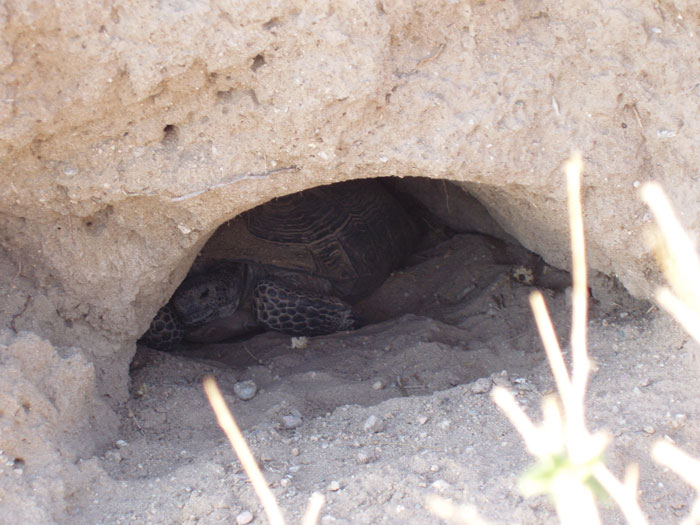Lawsuit Delays Largest Translocation in History
By Laura Cunningham
March 17, 2016 - The Center for Biological Diversity filed a notice of intent to sue on March 8 over military plans to expand the Marine Corps Air Ground Combat Center at Twentynine Palms in California, requiring that around 1,500 desert tortoises be tranlocated over a five year period. This would be the largest translocation effort ever in the history of the desert tortoise. The notice, filed under the Endangered Species Act, argues that federal agencies have failed to fully examine how the relocations might harm the tortoises in the Mojave Desert. The Center is challenging the failure of the Bureau of Land Management and Marine Corps to consult adequately with the U.S. Fish and Wildlife Service and fully address impacts both to translocated tortoises and to the habitat and tortoises already living in the relocation sites.
See the Center's press release here: http://www.biologicaldiversity.org/news/press_releases/2016/desert-tortoise-03-08-2016.html
The expansion area would take 88,000 acres in the Johnson Valley to be used for live ammunition training exercises. During a previous translocation effort to move desert tortoises out of an expansion area in Ft. Irwin Army National Training Center, 50% of tortoises suffered mortality due to the translocation. A 50% mortality rate over three years or more is usual for tortoises moved out of their home ranges. Predation is the most common cause of tortoise deaths. The Desert tortoise is a Federally Threatened species.
http://m.pe.com/articles/desert-797226-halts-legal.html
http://www.pe.com/articles/tortoises-796446-desert-filed.html
The second article is inaccurate when it says:" The relocation is expected to take a team of about 100 biologists as long as two to four weeks to complete." The translocation effort is so gigantic it will take five years to complete (members of Basin & Range Watch have previously worked as tortoise biologists for translocation projects).
More on the military expansion.
Leave the Tortoises Where They Are
October 23, 2010 - The growing science of Desert tortoise (Gopherus agassizii) conservation is up against a hardy foe this year: the politics of a renewable energy push which has demanded deadlines that do not allow careful planning and study of the desert-dwelling animals and plants on the vast project sites slated for development.
Spurred by December 31, 2010 deadlines for huge federal subsidies, the Fast-Track large-scale solar projects have run up against problems in mitigating impacts to the tortoise, a federally threatened species. Intense pressure from the administration to start construction of the several projects has put stress on both agencies and scientists to try to work out the ways that tortoises can be moved out of harm's way and compensation for lost habitat achieved. But is the tortoise actually the loser in this "win-win" situation?
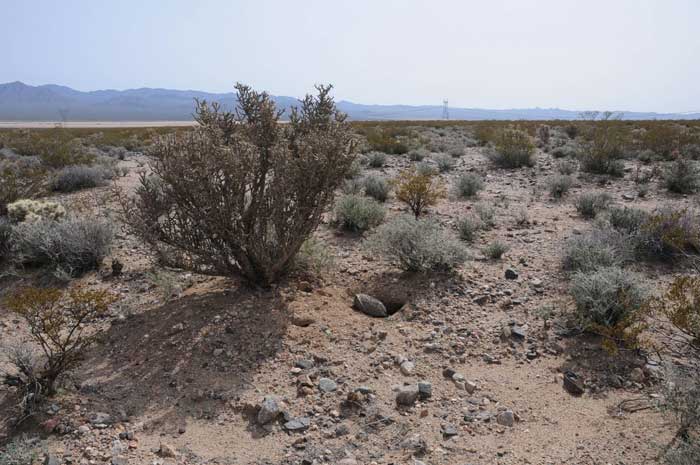
^Adult female tortoise emerges out of her burrow in Ivanpah Valley, to bask in the morning sun.
Ivanpah Valley Trouble
The final approval happened when Interior Secretary Ken Salazar signed the Right-of-Way on Thursday, October 14, that allowed BrightSource Energy to take temporary lease of the 3,400-acre parcel of Bureau of Land Management desert for its Ivanpah Solar Electric Generating System (ISEGS). Reports have it that BrightSource wasted no time, bringing in heavy machinery that night and beginning construction activities early the next morning on Friday in the dark.
An army of 50 tortoise biologists came out, monitoring all machinery, putting up tortoise exclusion fencing, and walking along five per blade (BrightSource is being generous, it is usually one), three blades working to make a wide perimeter road along the top of Phase 1. They must stop October 31 according to US Fish and Wildlife Service. There were a lot of water trucks, trucks carrying huge rolls of tortoise fencing, and security guards driving around.
By October 11 the crew has already found five adult tortoises along the fenceline of the entrance road, Coliseum Road. They were radio-telemetered and released, and before November 1 will be relocated, disease tested, and placed in the overwintering pens. Positive tortoises will be sent to the Las Vegas Desert Tortoise Conservation Center and put down.
By October 16 they had captured 15 adult tortoises and were checking them for disease and holding them for relocation into the area near the project in the Ivanpah Valley.
By October 22 the tortoise count had already risen to a total of 17, 16 adults and one juvenile. This was far more than were expected. By October 29 the count jumped to 28, according to BLM.
Based on how many tortoises have been found already experts think there could be 100 to 130 on the project site.
The only problem here is that the US Fish and Wildlife's Biological Opinion for the entire three phase project only expects 32 adult tortoises to be captured. A re-initiation of consultation is to take place when 38 tortoises are found over the entire three phase project.
All tortoises moved will be "translocated" regardless of distance, and the fenceline and perimeter road are setback within the ROW.
From the October 5, 2010 Tortoise Translocation Plan for ISEGS:
"...USFWS’s Biological Opinion for ISEGS (USFWS, 2010) referred to all movement of desert tortoises as translocation regardless of the distance moved." (p. 2)
"After an area is flagged, prior to any site clearance work, the perimeter of the area to be cleared will be fenced. Within 24 hours prior to the initiation of construction of the desert tortoise-exclusion fence, two complete desert tortoise clearance surveys of the proposed perimeter fence line and associated disturbance right-of-way (ROW) will be conducted using techniques providing 100 percent coverage of the construction area and an additional transect along both sides of the fence line transect to provide coverage of an area approximately 90 feet wide, centered on the fence alignment. Transects will be no greater than 30 feet apart. During these surveys, an authorized biologist will inspect all desert tortoise burrows, and burrows constructed by other species that might be used by desert tortoises, to determine occupancy. Any burrow within the fence line corridor will be collapsed after confirmation that it is not occupied by a desert tortoise, or if occupied, the desert tortoise has been removed (CH2M HILL, 2009). Two complete passes with complete coverage will be conducted as described above. If no desert tortoises are observed during the second pass, a third pass would not be conducted." (p. 5)
"To allow for external roads, the setback area will be a minimum of 20 feet wide within the ROW boundaries between the tortoise fence and the ROW boundary on the upslope boundary of the ROW, and a minimum 8 to 12 feet wide between the tortoise fence and ROW boundary on the side and downslope boundaries." (p. 5)
"All healthy desert tortoises will be translocated to the west or north of the project site (Figure 4). Those located over 500 meters of the western and northern fence line boundary will require a health assessment. Authorized biologists will preferentially place desert tortoises in safe locations that are within 1,000 meters (3,280 feet) of their collection location on the project site, with consideration for the 300-foot buffer. If this criterion cannot be met for a given desert tortoise, an authorized biologist will move the individual to the closest translocation area (N1 through N4) also west of the project site (Figure 4)." (p. 14)
US Fish and Wildlife Service Biological Opinion, Oct 1, 2010:
"...we anticipate that the proposed translocation areas can accommodate approximately 38 additional subadult and/or adult desert tortoises. Consequently, the proposed translocation areas appear to be large enough to accommodate all 32 subadult and/or adult desert tortoises that BrightSource needs to move. ...If the translocation areas prove to be too small, BrightSource would have to identify a new translocation area for the additional desert tortoises. This action would constitute a significant change in the project description and would likely require re-initiation of consultation." (p. 39-40)
"We anticipate that the translocation of approximately 32 subadult/adult desert tortoises from project facilities (Le., Ivanpah 1,2, and 3 project sites, the CLA, and natural gas distribution line) would involve take, in the form of capture and harassment, of all of these individuals." (p. 56) As many as 35 juveniles and 139 tortoise eggs are estimated to be on the project site, but only 15% of juveniles will survive it is thought.
"If 3 desert tortoises are killed or injured in any 1 year as a result of any construction, operation, maintenance, decommissioning, or restoration activities covered by this biological opinion, the Bureau must re-initiate consultation, pursuant to the implementing regulations for section 7(a)(2) of the Endangered Species Act at 50 Code of Federal Regulations 402.16, on the proposed action. This term and condition also applies to direct mortality and injury of desert tortoises during translocation and post-translocation monitoring on the resident, control, and translocated populations (i.e., due to handling, road kills caused by personnel working on the project). However, it does not apply to post-translocation mortality within these populations that is not connected directly to an action required to carry out the translocation and monitoring effort." (p. 60-61)
"By 'capture,' we mean the act, by authorized biologists (and monitors working under their supervision), of removing desert tortoises from their home ranges to be placed in a quarantine facility, translocated, or moved a short distance from harm's way. By 'harassment,' we mean the act, by authorized biologists, of collecting blood or conducting other invasive health assessments that may result in the likelihood of injury or mortality; see the regulatory definition of harassment in the Incidental Take Statement section of this biological opinion.' (Table footnotes)
Then the unthinkable happened: on October 21 a tortoise was killed. The report is sketchy, but apparently a tortoise was hit along a road and had to be taken to a veterinarian where it was euthanized. It remains to be seen how the company will handle this balancing act of not harming more tortoises while trying to get as much construction done as possible before federal funding deadlines close this year. The low initial estimates may have been due to 2007 surveys being done during a drought, when most tortoise remained hidden underground, skewing counts. Since then, rainier months in 2010 may have brought out more tortoises. Nature does not always cooperate with human schedules.
Tortoise surveys were surveys done in 2007. But this spring was during a drought. So tortoises were apparently not coming out of their burrows much. (Summer 2007 was wet, and many tortoises were seen, feeding on a garden of fall-flowering annual wildflowers.) Then in 2010 a wet year occurred, and all the tortoises come above ground. The trouble is not the surveyors, but the methodology. US Fish and Wildlife Service uses a presence-absence survey to guess the density of a tortoise population before construction begins. But this is a survey method that cannot possibly estimate numbers, only presence; then a statistical equation plus weather data are applied to try to come up with a population number. This does not seem to be working. It would take too much time and money to do the types of surveys that can actually estimate population density, like line distance sampling or mark-recapture. This is what happens when politics tries to bend science to its needs.
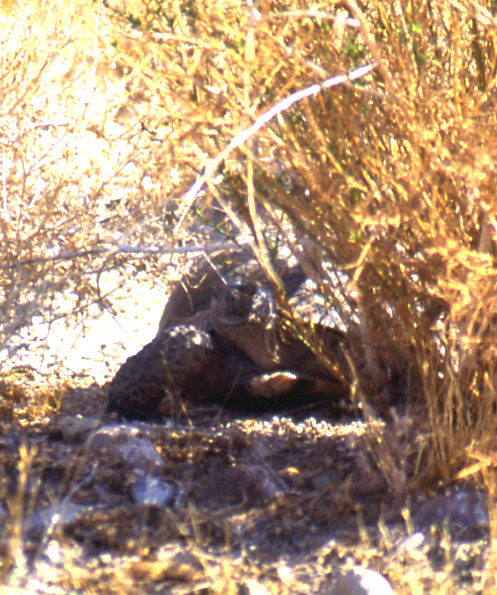
^An Ivanpah Valley tortoise rests in the shade of a shrub.
Calico Solar Project
At the August 18, 2010 California Energy Commission evidentiary hearing for the Calico Solar Project by Tessera Solar, which would be located in prime Desert tortoise habitat 40 miles east of Barstow, San Bernardino County, a bombshell was dropped. New guidance from the California Department of Fish and Game was worked into the tortoise translocation plan: 50% of all tortoises moved would be estimated to die, due to stress and predation. Also, 50% of resident tortoises at the recipient sites would also die, due to competition with the moved tortoises, and stress. Even 5% of tortoises at control sites would die due to the stress of handling (equal numbers of tortoises must be radio-telemetered in the translocation group, host group, and control groups to compare a population that was not subject to translocation activities). To top it off, the juvenile tortoise population would suffer an 85% mortality rate, because they are difficult to find and move out of harms' way. This would happen at every project site where tortoises had to be translocated.
At the August 25 hearing, premier tortoise biologist Dr. Kristin Berry, of United States Geological Survey-Biological Resources Division, was invited by the Energy Commission to clarify the biology of tortoise translocation. She has been studying the Desert tortoise since 1970, helped list the California population of the tortoise in 1990, and has several study plots in the Mojave Desert where she carries out research on tortoise diseases and translocation impacts.
The Calico site has surprised even the biologists by having more tortoises than expected, as determined by spring 2010 surveys. New guidance from US Fish and Wildlife Service directs calculating the population using equations based on the number of tortoise found to estimate the number of tortoise actually present, as most tortoises are usually hidden underground in their burrows.
Energy Commission biologists calculated that as many as 189 tortoises may be present on the project site and therefore have to be moved. Estimates were 93 adults and subadults, 96 juveniles, and 436 eggs. California Department of Fish and Game stated that this would be the largest "take" permit they would ever have issued for tortoises.
Tessera had prepared only a draft Tortoise Translocation Plan, yet expected to begin moving tortoises in a phased approach this fall. Fish and Wildlife Service only allows the Federally Threatened tortoise to be translocated in September-October, and April-May, if weather conditions allow.
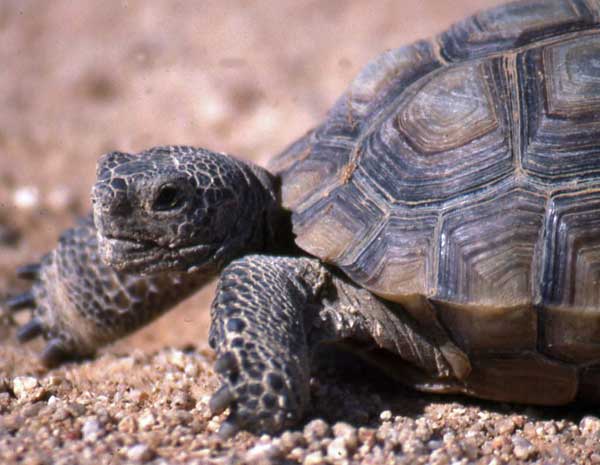
Dr. Berry wasted no time attacking the proposed tortoise translocation for the Calico project. She said it did not appear well-planned, nor science-based, but hastily put together and not supported by quantitative data measuring annual and perennial vegetation, soils, and surficial geology (which would give the suitability of areas for burrowing). Berry continued that the plan drew on USGS tortoise habitat models, but that this was not validated locally. She said the translocation plan authors were using layers of assumptions unsupported by science, such as the phrase 'carrying capacity' without definition.
So high were the estimated tortoise numbers to be moved, that the agencies balked. Tessera was asked to reduce the acreage of their project drastically (by 45%), moving out of the main density of tortoises on the upper alluvial fan. Tessera opted to remove the flood-control detention basins along the top of the project, and keep a similar number of 26,540 Stirling dishes so they could keep their high megawatt output. This may create other problems, however, as with this alternative project layout no flood drainage plan was enacted, and this angered the railway, BNSF, whose track lay downhill in the midst of the sprawling development.
On October 28, 2010, the California Energy Commission approved the Calico Solar Project, estimating only 22 tortoises would be found in the reduced project footprint. Yet the translocation plan was only received six days prior to the licensing hearing, giving the public and parties involved no time to review it. There was still no evidence given that off-site land should be found and purchased that would mitigate for habitat lost to the project. And no studies have yet shown the enhancement measures such as fencing will actually raise the carrying capacity of an area. Under the California Endangered Species Act, impacts must be fully mitigated, and all actions must be shown to work. The tortoise is both a Federally Threatened and State Threatened species.
The unprecedented action of allowing hibernating tortoises in their burrows to be fenced off and construction begun around them, was included in the translocation plan. No other approved solar project has allowed this. The danger exists that as SunCatcher poles are vibrated into the ground around burrow openings, they will actually hit the underground part of the burrow. Tortoise burrows may go 15 feet long under the desert surface, and make unpredictable sharp turns in various directions. The pole-driving vibrations could also have disturbing impacts on the tortoises as well.'
Lessons From Fort Irwin
At the August 25 Calico Solar Project evidentiary hearing with the California Energy Commission, Defenders of Wildlife testified as to the impacts that translocating large numbers of tortoises has had during expansion of the Fort Irwin National Training Center. This translocation was very well-studied.
In one part of the translocation process, Dr. Kritin Berry was in charge of moving 158 tortoises in March 2008:
- By December 2008, 43 tortoises were dead or dying and 15 were missing.
- By December 2009, 27 more tortoises died, and 20 were missing. The death rate so far was 44.7%.
- In January 2010 only 68 tortoises were alive, 20 missing.
- 8 died in 2010 up to August, and a total of 23 missing; the mortality rate was 11.6%.
- The grand total of all years was 49% dead by August, and 23 missing (where often a predator tore off the radio transmitter).
Dr. Berry stated that this was a very high death rate, mostly due to coyote and raven predation. Drought years such as 2007 exacerbated coyote predation. Even adult tortoises were being killed by ravens flipping the reptiles over and pecking at their cloaca and hindlegs. Feral dogs also are a problem. Two tortoises were killed by vehicles on dirt roads. One tortoise was bitten by a rattlesnake, and another was killed by a Golden eagle. A few died of hyperthermia (over-heating). One died of gout.
She had another study plot in the area, at Daggett, to research epidemiology. From January to August 2010 the plot had only 2.5% mortality out of 78 tortoises. Another study site in the Soda Mountains has had no deaths.
Having studied the Desert tortoise since 1970, Berry said she has seen several populations with high density decline markedly due to disease and other threats. We no longer have high density populations in the state. So the Calico site, formerly considered of low to moderate density, now becomes more important, especially since it is remote from towns. "With the continued decline of the tortoise in California, and our inability to stabilize populations, the Calico population becomes more important. I would not have said this 15 to 20 years ago. Now I do," she stated.
Dr. Berry stressed the need for a very sound study plan for translocation, with quantitative and qualitative information. There are many types of creosote bush communities, we need to know the ages of alluvial fan surfaces -- some are 100-500 years old, others are 500,000 years old. This affects vegetation and burrows. The plans need more careful treatment of disease as well.
The Mojave population of the Desert tortoise was federally listed in 1990, and by 1994 Critical Habitat was designated and published in a Recovery Plan, based on information available at the time, and the state of the populations at the time. Dr. Berry said that 20 years later, populations have declined greatly, and the West Mojave population crashed. So now the Critical Habitat design sometimes no longer has viable habitat. Areas outside such Critical Habitat now become more important.
Ashleigh Blackford of the US Fish and Wildlife Service responded that "we understand this project is not about recovery. It is about minimization."
But the risk to the tortoise is extinction.
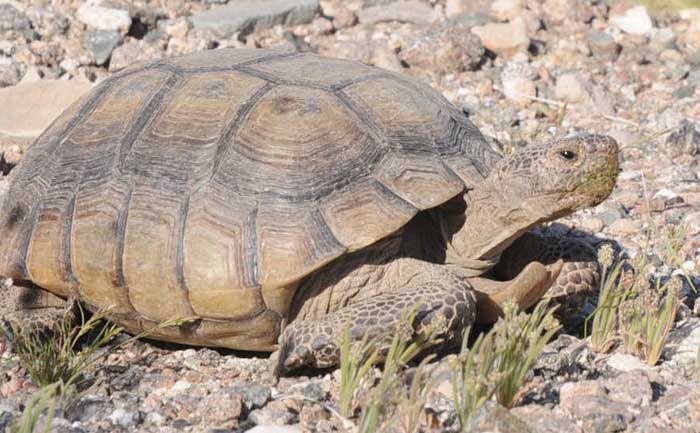
^A male tortoise dines on green plantain (Plantago ovata) in spring.
Translocated tortoises will try to go back to their home range, pushing against fences newly put up to exclude them. Tortoises need to drink, and will use the same drinking site year after year -- a scrape they dig in a hard desert surface that collects rainwater. They have a long-term memory, and if moved will not know where to drink.
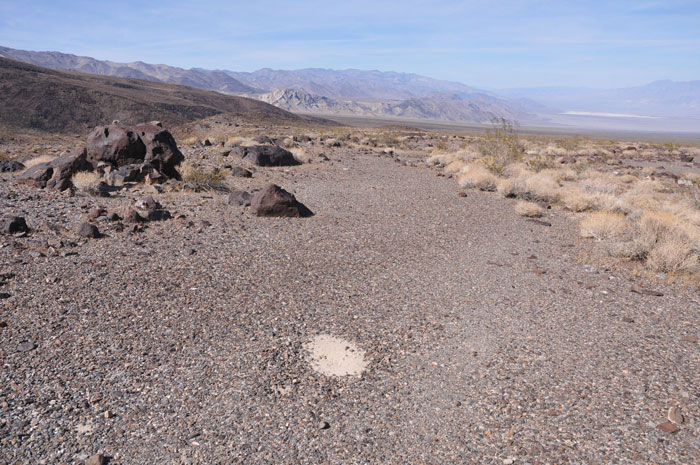
^Scrape perhaps dug by a jackrabbit in desert pavement. These collect rainwater and serve as drinking stations for animals. Tortoise dig similar "dishes."
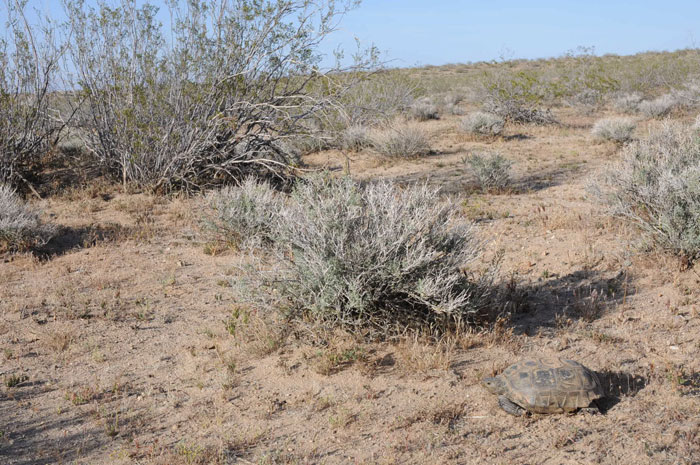
^Female tortoise in a large wash next to the proposed Ridgecrest Solar Power Project in the West Mojave Desert.
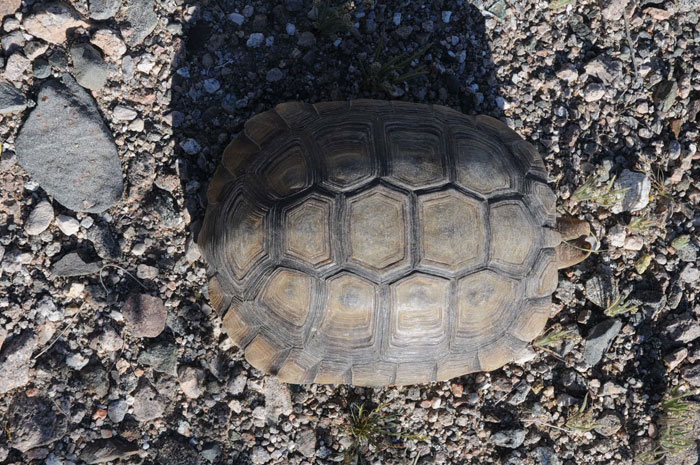
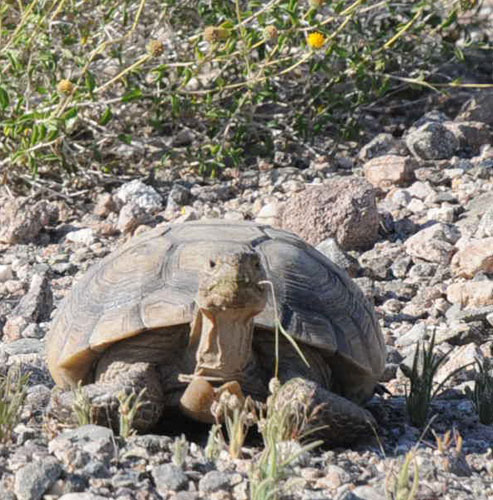
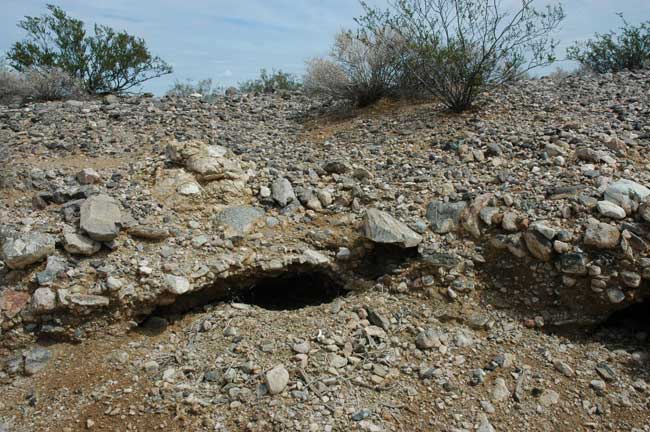
^Tortoise burrow at the proposed Silver State Solar Project in Ivanpah Valley, Nevada.
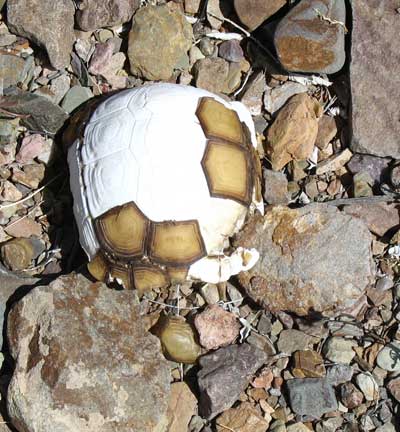
^Tortoise carcass. This may become all too common if translocation dominates the management of tortoises.
Cumulative Impacts
The tally of tortoise numbers on the solar projects in California and Nevada is large. The numbers seem to show some areas have had recent die-offs but could recover in the future as the habitat is good (as in the Ivanpah project, California). Other areas are dense still. Only Genesis looks like it may be too low for a tortoise population in the present climatic phase, but just down the valley at Desert Sunlight there is a surprisingly high density at a slightly higher elevation.
Calico Solar Project (Tessera Solar) - 78 tortoises in revised project footprint (Jeff Aardahl Rebuttal testimony, Intervenor Defenders of Wildlife, July 29, 2010). 189 tortoises estimated on August version of the project site, including 93 adults/subadults and 96 juveniles, as well as an estimated 436 eggs. (CEC August 25, 2010 evidentiary hearing). 4.7 tortoises/km2 in Ord-Rodman DWMA, recipient area for translocation, with signs of die-off 2-3 years ago (CEC evidentiary hearing August 5, 2010). Project footprint since reduced.
Ivanpah Solar Electric Generating System (BrightSource Energy) - 25 found with sign of die-off (2007-2008 surveys, with 97 carcasses, 214 burrows, (ISEGS PMPD).
Blythe Solar Power Project (Solar Millennium and Chevron Energy Solutions) - 4 tortoises on project site as of October 25, 2010, possibly as many as 20, but there may have been a population crash - 65 burrows and 383 shell remains (FEIS and BLM personal communication).
Palen Solar Power Project (Solar Millennium and Chevron Energy Solutions) - 0 on project site, 7 in Buffer Area and Proposed Project Study Area. 4 burrows in Buffer Area, 59 carcasses /bone fragments, including 1 on project site (May 7, 2010 letter from AECOM to CEC).
Genesis Solar Energy Project (NextEra) - 0 on project site. 30 bone fragments outside project area, most mineralized, may be very old - a few thousand years (June 11, 2010 letter from Tetra Tech EC, Inc. to CEC).
Desert Sunlight Solar Project (First Solar) - 40 on Project Study Area (estimated 55-85 tortoises), 15 (20-30 estimated) on Preferred Project Site footprint (Biological Assessment 2009).
Silver State Solar Project (First Solar, formerly NextLight) - 4 on project site. 18 carcass/bone fragments on site. 95 burrows/cover sites on site. 28 scats on project site, 20 the year of survey. About 20 - 50 tortoises/mile2 (Sundance Biology, Inc. -CH2M HILL, Inc., October 2009, Presence/Absence Survey for the Desert Tortoise (Gopherus agassizii), on the Proposed Silver State Solar Project in Ivanpah Valley, Clark County, Nevada). 150 estimated tortoises on project site (BLM Scoping Meeting June 1, 2010). Our estimate is higher due to very dense burrows and sign during site visits in 2009, burrows and sign more common than at Calico.
Lucerne Valley Solar Project (Chevron Energy Solutions) - 2 on project site, 7 in Buffer Area. 5 carcass/bone fragments on or near project site. 33 burrows on project site, 30 in 500-foot Buffer Area, 44 in adjacent areas (FEIS).
Ridgecrest Solar Power Project (Solar Millennium) - 40 on project site, including 12 juveniles., 23 adults, 5 not measured. Density estimate 8.1-9.8 tortoises/km2. (West Mojave USFWS rangewide monitoring transects using line-distance sampling: 4.7/km2 in 2007, Northeast Mojave 1.7/km2 in 2007. Nearby Fremont Peak tortoise study plot dropped from 39/km2 in 1980 to zero in 2007. Fremont Valley-more than 100/km2 in 1981 to about 10/km2 in 2007 (CEC Workshop in Ridgecrest, May 3, 2010).
Amargosa Photovoltaic Solar Project (Pacific Solar Investments) -1 in Right-of-Way. The Amargosa Valley tortoise population is not dense, but genetically unique and less ridden with disease than in other parts of the desert. It should not be fragmented.
Amargosa Farm Road Solar Project (Solar Millennium) - 0 on project site according to the Draft Environmental Impact Statement, but we have found burrows here.
Lathrop Wells Solar Project (Abengoa Solar) - not surveyed yet.
If the ISEGS project is any indication, many of these counts may be underestimates.
HOME.....Ivanpah Solar Electric Generating System.....Calico Solar Project
Ridgecrest Solar Power Project.....Chuckwalla Valley Projects.....Silver State
